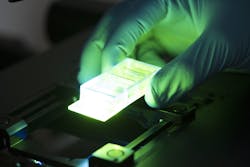Biosensors: Quantum technology promises better biosensors
Biosensors are considered among the most promising of tools for addressing a broad range of biomedical and public health concerns, including disease diagnosis, identification of multidrug-resistant organisms, early detection of burgeoning epidemics, and detection of low-concentration toxins and pathogens in food and drinking water. In fact, all of these applications are goals of current research programs.
Scientists and engineers working on these issues face enormous challenges, however. For instance, biosensors being developed to increase the reliability and efficiency of medical diagnoses must be sufficiently sensitive to detect even the smallest amounts of pathogens in blood or other biological fluids. At the same time, they should be able to identify even difficult-to-diagnose diseases in real time so that therapy can be deployed as early as possible.
Achieving both of these goals is beyond the scope of currently developed technologies, according to scientists at Project BioSensing, a collaboration among two of Germany’s Fraunhofer institutes and Leiden University’s Institute of Physics (Leiden, Netherlands). The project was developed to overcome the limits of modern biosensors by applying quantum technology.
Project BioSensing focuses on a novel class of fluorescing biological nanomaterials called DNA-stabilized metal quantum clusters (QC-DNAs), which serve as “quantum biosensors.” In their simplest form, these biosensors consist of a short DNA sequence that encloses a group of six to 15 metal atoms (the so-called metal cluster). The choice of DNA sequence determines the characteristics of the sensor—for instance, which disease it is able to detect. The basic structure of a quantum biosensor can be extended by adding specific biomolecules, which can enable the detection of selected biomarkers. The fluorescence properties of the metal cluster enable reporting: When the target is detected, the light emitted by the metal clusters shifts wavelength. A significant advantage of the technology is cost-effective production.
Foundations for the future
BioSensing is funded by Fraunhofer’s International Cooperation and Networking (ICON) program, which supports research in cooperation with international centers of excellence and creates opportunities to transfer basic research results into practice. It takes advantage of the expertise of Leiden University’s Dirk Bouwmeester, professor of quantum optics and quantum information, and his strong interest in DNA-stabilized metal quantum clusters.1 His QC DNA work promises insights into the quantum physical relationships of these materials, and how they might improve biosensor efficiency (see figure). Among Bouwmeester’s experiments is development of a nanomirror that can actually occupy two positions simultaneously.
The Fraunhofer Institute for Silicate Research (ISC; Würzburg, Germany) is contributing experience in the chemical synthesis and characterization of materials, and the development of biomaterials for design and manufacture of the quantum biosensors. Leiden University’s Doris Heinrich, professor of biophysics, and her 3D NanoCell Group are furthering this work by studying the dependence of quantum biosensor synthesis on the starting materials and synthesis process conditions.2 They are also developing microfluidic lab-on-chip systems for diagnostics.
Greta Nölke and her team at the Fraunhofer Institute for Molecular Biology and Applied Ecology (IME; Schmallenberg, Germany) are contributing expertise in recombinant protein and antibody technologies, biomolecule functionalization, and the development of technologies and assays for pathogen and toxin detection.3 Further work includes cell-based assays for high-throughput microscopy on biological markers and for toxicity evaluation (of nanomaterials, for instance).
QC-DNAs are suitable for the development of highly sensitive sensors in biological systems and promise advanced, intelligent, and affordable therapy. The project partners are designing numerous quantum biosensors, which they plan to scale up and prepare for feasibility studies in university hospitals. In follow-up projects, they plan to develop a highly sensitive yet cost-effective portable read-out device that works quickly and reliably to detect various pathogens, toxins, and cancer cells.
REFERENCES
1. D. de Bruin et al., J. Nanobiotechnol., 16, 37 (2018).
2. N. Bossert et al., Sci Rep., 7, 45882 (2017).
3. S. Achtsnicht et al., PLoS One, 14, 7, e0219356 (2019).

Barbara Gefvert | Editor-in-Chief, BioOptics World (2008-2020)
Barbara G. Gefvert has been a science and technology editor and writer since 1987, and served as editor in chief on multiple publications, including Sensors magazine for nearly a decade.
